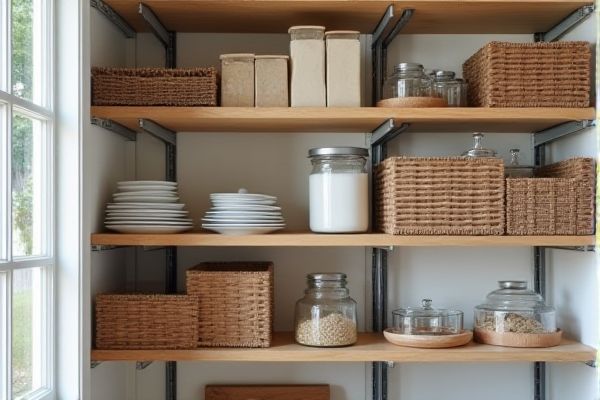
Open grid shelving in a pantry allows for better air circulation and visibility, making it easier to spot items and maintain freshness, while solid shelving offers more support and prevents smaller items from falling through. Explore the rest of the article to discover which option best suits your pantry needs and lifestyle.
Table of Comparison
| Feature | Open Grid Shelving | Solid Shelving |
|---|---|---|
| Airflow | Excellent ventilation, reduces moisture build-up | Limited airflow, risk of humidity accumulation |
| Visibility | High visibility, easy to locate items | Lower visibility, items may be hidden |
| Cleaning | Easy to clean, dust falls through | Requires regular cleaning, surfaces collect dust |
| Weight Capacity | Typically lighter load capacity | Higher weight support, ideal for heavy items |
| Durability | Durable but susceptible to bending if overloaded | Strong and sturdy, withstands heavy use |
| Aesthetic | Modern, open look that enhances pantry space | Traditional, solid appearance with a clean look |
| Price | Generally more affordable | Typically higher cost due to material |
Introduction to Pantry Shelving Options
Open grid shelving in pantries offers enhanced air circulation and visibility, making it easier to monitor food inventory and reduce moisture buildup. In contrast, solid shelving provides a sturdy, flat surface ideal for stacking canned goods and prevents smaller items from falling through gaps. Both options serve different organizational needs and can be selected based on preferred accessibility and storage type.
What Is Open Grid Shelving?
Open grid shelving consists of metal or wire racks with an open, grid-like design that allows air circulation and visibility, making it ideal for pantry storage. This type of shelving prevents dust accumulation and promotes freshness by improving ventilation around stored items. Unlike solid shelving, which is made of continuous wood or metal panels, open grid shelving maximizes airflow and reduces moisture buildup in pantry spaces.
What Is Solid Shelving?
Solid shelving in a pantry consists of flat, continuous surfaces made from materials like wood, metal, or laminate that provide sturdy and uniform support for storing items. These shelves prevent smaller objects from falling through gaps, making them ideal for organizing canned goods, jars, and loose pantry items. Your choice of solid shelving enhances stability and cleanliness, ensuring easy maintenance and maximized storage space.
Ventilation and Airflow: Open Grid vs Solid
Open grid shelving in a pantry promotes superior ventilation and airflow, allowing air to circulate freely around stored items which helps prevent moisture buildup and mold growth. Solid shelving restricts airflow, potentially trapping humidity and odors, which can lead to faster spoilage of pantry goods. Choosing open grid shelves ensures Your pantry stays fresh and dry by maintaining consistent air movement.
Cleaning and Maintenance Considerations
Open grid shelving in pantries allows for better air circulation and easier visibility of items, making spot cleaning simpler and reducing dust buildup. Solid shelving requires thorough dusting and wiping to prevent grime accumulation on the flat surfaces, often needing more frequent maintenance. Both types benefit from regular cleaning, but open grid designs generally offer a low-maintenance advantage due to minimized surface area for dirt to settle.
Strength and Weight Capacity
Open grid shelving offers greater airflow and visibility but typically supports less weight compared to solid shelving, which provides superior strength and higher weight capacity for heavy pantry items. Solid shelving is ideal for storing dense products such as canned goods and bulk containers, ensuring stability and durability under significant loads. Your choice depends on whether you prioritize ventilation or maximum load-bearing capability in your pantry organization.
Accessibility and Visibility of Pantry Items
Open grid shelving enhances accessibility and visibility by allowing clear sightlines and easy reach to pantry items, reducing the time spent searching for ingredients. Solid shelving can obscure items, requiring more effort to access and often necessitating additional organization tools to maintain order. Grid designs also promote airflow, helping to keep pantry contents fresh and visible, whereas solid shelves may obscure items and limit quick identification.
Aesthetics and Design Flexibility
Open grid shelving in pantries offers a modern, airy look that enhances visibility and accessibility while allowing airflow to keep stored items fresh. Solid shelving provides a more traditional, streamlined appearance that conceals clutter and supports heavier storage needs, adding a sense of order and privacy. Designers often prefer open grid shelves for customizable displays and dynamic kitchen aesthetics, whereas solid shelves excel in creating a clean, minimalist pantry space.
Cost Comparison: Open Grid vs Solid Shelving
Open grid shelving typically costs less than solid shelving due to lower material usage and simpler manufacturing processes. Solid shelving, made from wood or composite materials, incurs higher expenses because of thicker panels and finish treatments. Choosing open grid shelving can reduce pantry installation costs by up to 30%, making it a budget-friendly option for maximizing storage space.
Which Shelving Is Best for Your Pantry?
Open grid shelving offers superior air circulation, making it ideal for storing fresh produce and preventing moisture buildup in pantries. Solid shelving provides a sturdy surface perfect for holding small or slippery items that might fall through grid patterns, ensuring organized and secure storage. Choosing the best shelving depends on pantry contents and ventilation needs, as open grids enhance airflow while solid shelves support stability and versatility.
 homyna.com
homyna.com